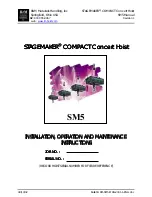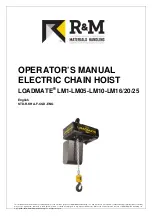
Disassembly may be required for HEAVY or SEVERE usage. Keep accumulative written records of
periodic inspections to provide a basis for continuing evaluation.
Inspect all items in “Frequent Inspection.” Also inspect the following:
1.
FASTENERS. Check rivets, capscrews, nuts, cotter pins and other fasteners on hooks, hoist
body and chain bucket, if used. Replace if missing and tighten or secure if loose.
2.
ALL COMPONENTS. Inspect for wear, damage, distortion, deformation and cleanliness. If
external evidence indicates the need for additional inspection return the hoist to your nearest
Ingersoll-Rand service repair center.
3.
HOOKS. Inspect hooks for cracks. Use magnetic particle or dye penetrant to check for cracks.
Inspect hook retaining parts. Tighten or repair, if necessary. Refer to applicable specifications
for additional hook inspection information.
4.
CHAIN SHEAVES. Check for damage or excessive wear. If damage or wear is noted, return
the hoist to your nearest Ingersoll-Rand service repair center.
5.
LOAD CHAIN. Measure the chain for
stretching by measuring across five link
sections all along the chain (ref. Dwg.
MHP0041). When any five links in the
working length reach or exceed the discard
length shown in Table 2, replace the entire
chain. Always use a genuine Ingersoll-Rand
Material Handling replacement chain.
6.
BRAKES. Raise a load equal to the rated
capacity of the hoist a few centimeters (inches)
off the floor. Verify hoist holds the load
without drift. If drift occurs, contact your
nearest service repair center for repair
information.
7.
SUPPORTING STRUCTURE. If a permanent
structure is used inspect for continued ability
to support load.
8.
LABELS AND TAGS. Check for presence and legibility. Replace if necessary.
9.
END ANCHOR. Ensure end anchor on hoist is installed and unbent. Repair if damaged, replace
if missing.
Hoists not in Regular Service
1.
Hoists which have been idle for a period of one month or more, but less than one year should be
given an inspection conforming with the requirements of "Frequent Inspection" before being
placed in service.
2.
Hoists which have been idle for a period of more than one year should be given a complete
inspection conforming with the requirements of "Periodic Inspection" before being placed in
service.
3.
Standby hoists should be inspected at least semi-annually in accordance with the requirements
of "Frequent Inspection." In abnormal operating conditions equipment should be inspected at
shorter intervals.
7
ENGLISH
Table 2
Hoist
Capacity
Chain
Size
Normal
Length
Discard
Length
mm
inch
mm
inch
mm
MCH5 and VL2
1/2 ton
5,0
2,95
75,0
3,03
77,0
1 ton
6,3
3,76
95,5
3,85
97,9
1-1/2 ton
7,1
4,17
106,0
4,28
108,7
2 ton
8,0
4,72
120,0
4,84
123,0
3 ton
7,1
4,17
106,0
4,28
108,7
5 to 20 ton
9,0
5,35
136,0
5,47
139,0
SM
1/2 ton
5,0 x 15
2,95
75
3,03
77
1 ton
6,3 x 19
3,74
95
3,83
97,4
1-1/2 ton
8,0 x 24
4,72
120
4,85
123
2 ton
6,3 x 19
3,74
95
3,83
97,4
3 ton
8,0 x 24
4,72
120
4,85
123
5 ton
9,0 x 27
5,30
135
5,43
138






























